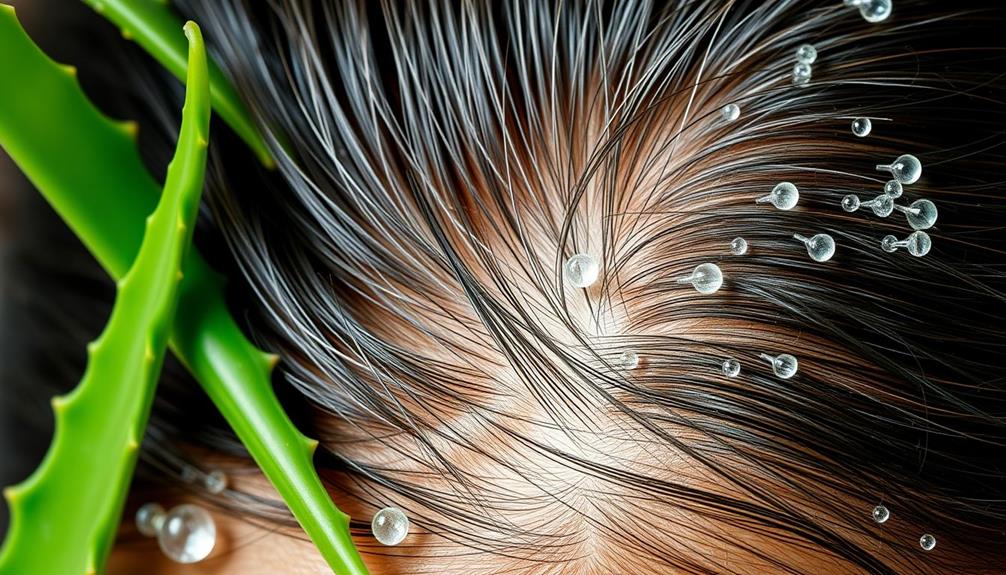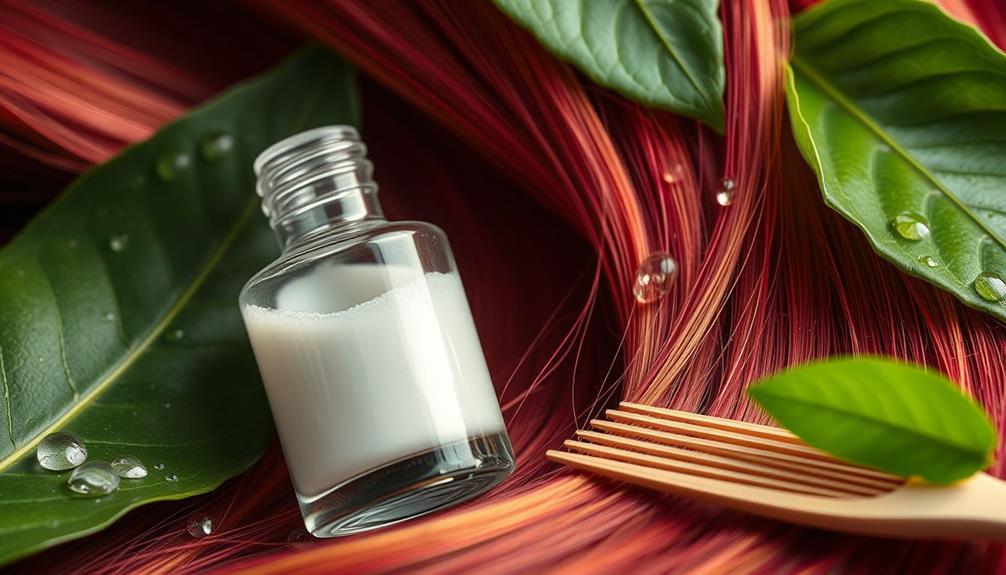Glycolic acid is essential for maintaining scalp health. It exfoliates dead skin and removes buildup, promoting a smoother, hydrated scalp. This alpha-hydroxy acid helps balance your scalp's pH, which can reduce dandruff and flakiness. By improving hydration, glycolic acid enhances the effectiveness of hair care products you use. To get the most out of it, apply a serum or toner on damp hair once or twice a week. Just make sure to start with a lower concentration and perform a patch test first. If you want to uncover more tips and insights, stick around for further details!
Key Takeaways
- Glycolic acid effectively exfoliates dead skin cells, improving scalp health and promoting a smoother surface.
- Regular use balances scalp pH and enhances hydration, helping to reduce dandruff and flakiness.
- Apply glycolic acid on damp hair for better absorption, starting with lower concentrations to minimize irritation.
- Combining glycolic acid with salicylic acid targets both dead skin and excess oil for comprehensive scalp care.
Understanding Glycolic Acid
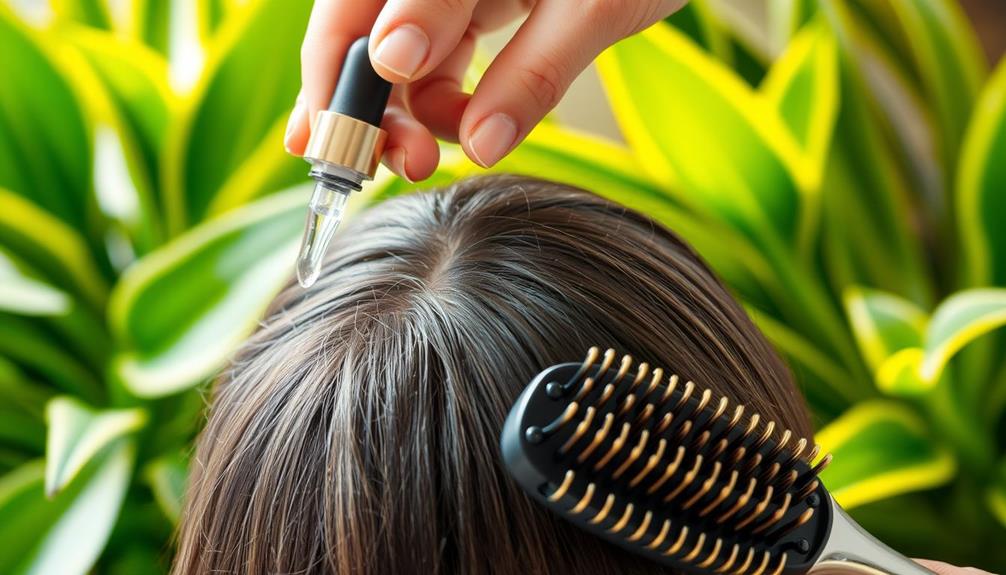
What makes glycolic acid stand out among alpha-hydroxy acids is its ability to deeply exfoliate the scalp, thanks to its small molecular size. This unique feature allows it to penetrate effectively, breaking down the bonds between dead skin cells. By doing so, glycolic acid facilitates their removal, leading to a smoother and healthier scalp surface.
Incorporating essential oils like lavender oil can further enhance your scalp's health, as they promote circulation and nutrient delivery to hair follicles.
In your hair care routine, incorporating glycolic acid can make a significant difference, especially if you struggle with product buildup or an oily scalp. Its exfoliating properties help clear excess oil and debris, ensuring your scalp remains clean and refreshed.
Regular use of glycolic acid not only enhances your scalp health but also helps maintain ideal moisture levels. This hydration is vital, as it enhances the effectiveness of other hair care products you apply.
When choosing products, look for formulations that highlight glycolic acid as a key ingredient. You'll likely find that your scalp feels revitalized, leading to healthier hair growth and improved overall hair quality.
Understanding how glycolic acid works is essential for maximizing its benefits in your hair care routine.
Benefits for Scalp Health
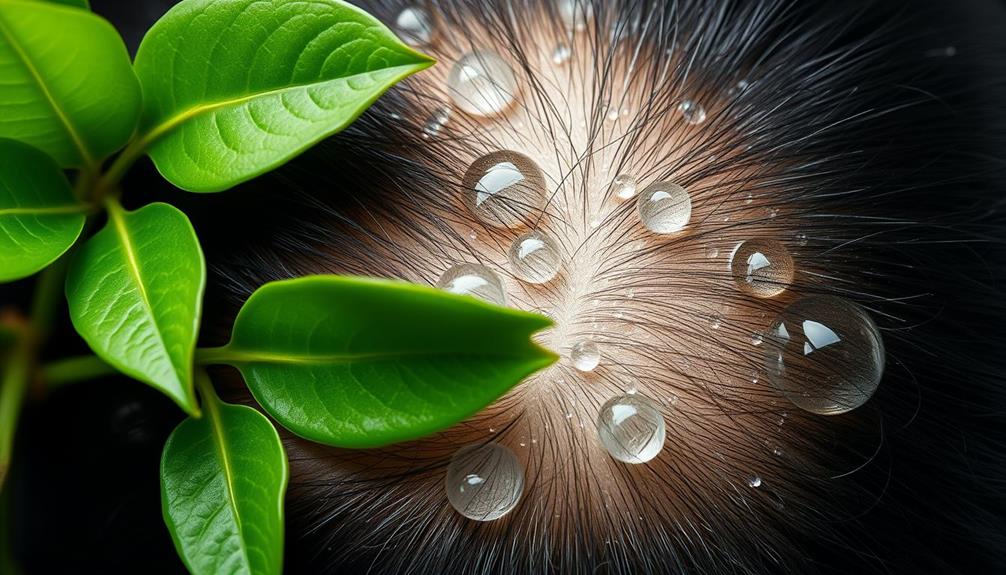
Glycolic acid offers significant benefits for your scalp health by exfoliating dead skin and removing buildup.
This process not only enhances hydration but also helps balance your scalp's pH, making it more resilient against issues like dandruff.
Additionally, incorporating essential oils into your regimen can further promote a healthy scalp environment.
Exfoliation and Debris Removal
Regular exfoliation with glycolic acid helps you achieve a cleaner, healthier scalp by effectively removing dead skin cells and product buildup.
Glycolic acid works by dissolving the bonds between these dead skin cells, making it easier for you to get rid of them. This process not only promotes a healthier scalp environment but also reduces flakiness and dandruff, enhancing your overall scalp health. Additionally, incorporating specialized hair products can maximize these benefits, as seen with hair products for curly hair that often highlight the importance of hydration and moisture retention.
Moreover, the small molecular size of glycolic acid allows it to penetrate deeply, tackling stubborn product buildup and debris. By incorporating glycolic acid into your scalp care routine, you can enjoy improved moisture retention. This means your scalp stays hydrated, preventing dryness and irritation caused by debris accumulation.
With regular use, glycolic acid can also enhance the absorption of other hair care products, ensuring they work more effectively on your hair and scalp.
Hydration and Scalp Balance
Achieving ideal hydration and balance in your scalp is essential for supporting healthy hair growth and preventing issues like dryness and irritation. Glycolic acid plays a pivotal role in this process by acting as a moisture magnet, enhancing hydration levels in your scalp while promoting a balanced environment for hair follicles.
Here are some key benefits of glycolic acid for scalp health:
- Exfoliates Dead Skin Cells: It helps remove dead skin cells and debris, preventing dryness and flakiness.
- Improves Moisture Absorption: The exfoliating properties allow for better absorption of hydrating ingredients in your hair care products.
- Regulates Sebum Production: Regular use can help balance sebum production, reducing oiliness and irritation.
- Balances Scalp pH: Maintaining a balanced scalp pH can minimize both dryness and oiliness, contributing to overall hair health.
Glycolic Acid Application Techniques
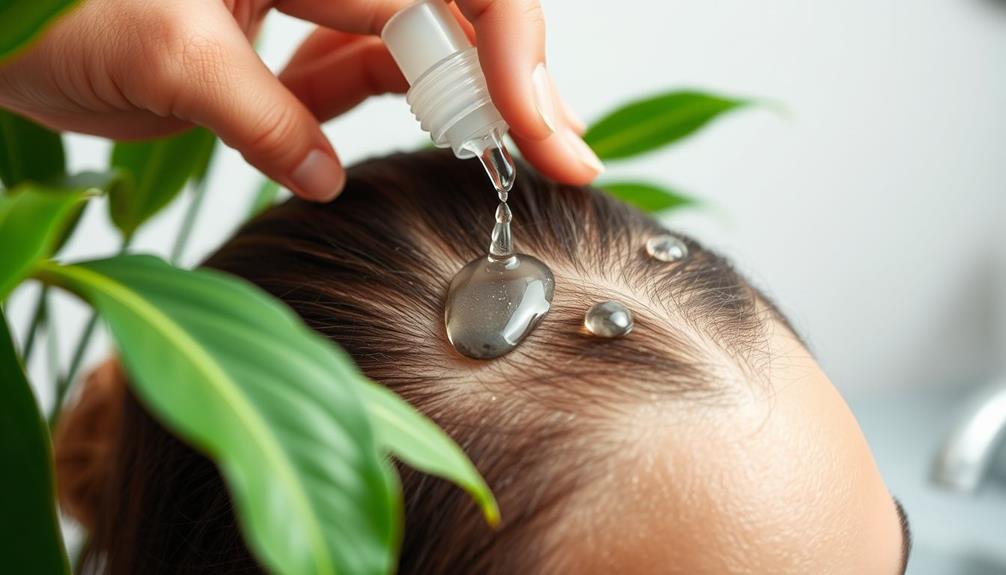
To maximize the benefits of glycolic acid for scalp health, apply it on damp hair to enhance absorption and effectiveness.
Start with a glycolic acid serum or toner at a lower concentration, ideally between 5-7%. This helps your scalp acclimate to the treatment while minimizing the risk of irritation.
After washing your hair, gently massage the serum directly onto your scalp, ensuring even distribution.
For best results, the application frequency should be once or twice a week. If you're using leave-on products, let them sit for about 5-10 minutes before rinsing thoroughly. This duration allows the glycolic acid to work its magic, exfoliating dead skin cells and promoting a healthier scalp environment.
Before diving into regular use, always perform a patch test on a small area of your scalp. This precaution checks for any adverse reactions, especially if you have sensitive skin.
Risks and Precautions
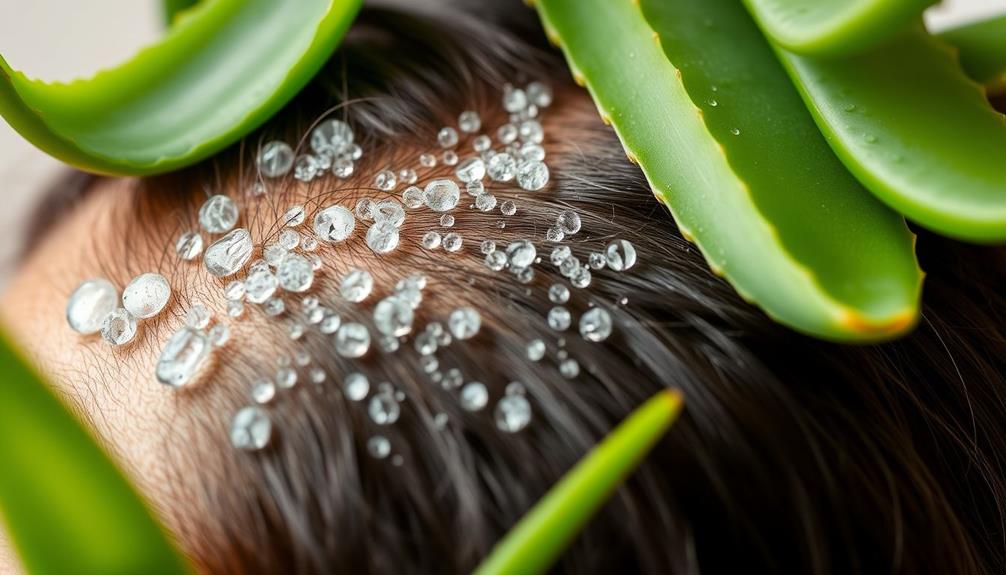
Using glycolic acid can pose risks, especially for those with sensitive or inflamed scalps, so it's important to proceed with caution. To guarantee your safety and avoid complications, consider these precautions:
- Consult a dermatologist before using glycolic acid, particularly if you have sensitive skin or existing scalp conditions. They can provide personalized advice.
- Avoid using glycolic acid on broken skin or open sores. This can exacerbate irritation and discomfort, leading to further issues.
- Steer clear of applying glycolic acid products right after chemical treatments like rebonding or straightening. Doing so can increase the risk of damage and irritation.
- Don't forget sun protection. Glycolic acid can heighten sensitivity to UV rays, making it essential to use sunscreen to prevent sunburn and skin damage.
Comparison With Salicylic Acid
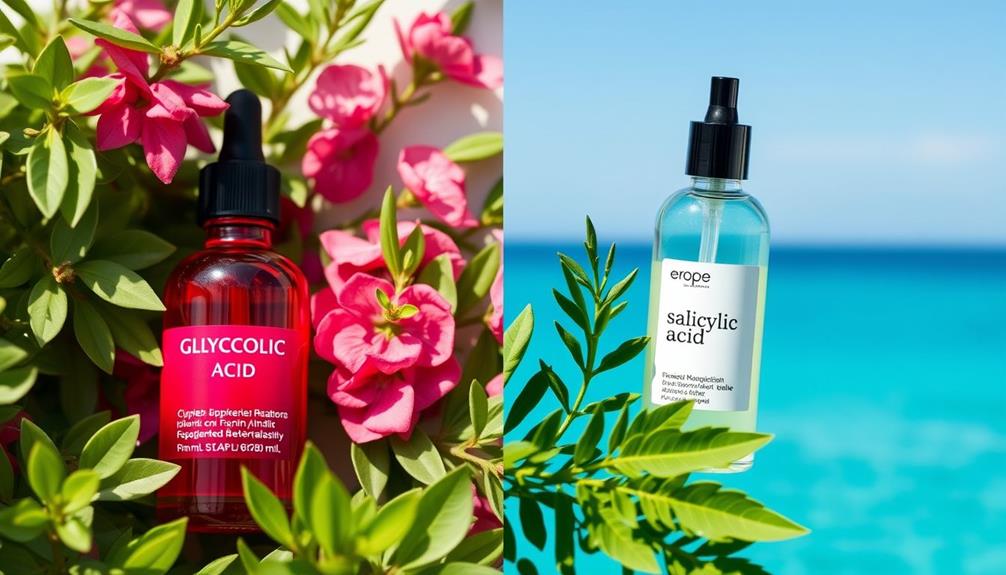
When comparing glycolic acid and salicylic acid, you'll notice key differences in their molecular structures that influence how they work on your scalp.
Glycolic acid penetrates deeper, focusing on exfoliating dead skin cells,
while salicylic acid targets oiliness and acne at the surface level.
Understanding these differences can help you decide how to combine their benefits for ideal scalp health.
Molecular Structure Differences
Glycolic acid, the smallest alpha-hydroxy acid, penetrates the skin more deeply than salicylic acid, which features a larger molecular structure and primarily targets the skin's surface. This difference in molecular structure plays a significant role in their effectiveness for scalp health.
Here are four key points to take into account:
- Exfoliation: Glycolic acid effectively dissolves the bonds between dead skin cells, promoting better exfoliation and skin renewal.
- Depth of Action: Due to its smaller size, glycolic acid can reach deeper layers of the scalp, addressing issues that salicylic acid may not penetrate.
- pH Levels: Glycolic acid works best at a pH of 3.5 or higher, which can result in less irritation compared to salicylic acid, which often requires a lower pH.
- Complementary Benefits: While glycolic acid enhances overall skin texture, salicylic acid effectively targets acne and excess oil, making them a potent combination for scalp health.
Treatment Mechanisms Explained
How do glycolic acid and salicylic acid differ in their treatment mechanisms for scalp health?
Glycolic acid is a small molecule alpha-hydroxy acid that penetrates deeply into the scalp, effectively exfoliating dead skin cells. This deep action promotes a healthier environment for hair growth and enhances scalp hydration, making it a strong choice for those dealing with product buildup.
On the other hand, salicylic acid is a larger beta-hydroxy acid that works mainly at the surface level, dissolving excess oil and unclogging pores. This makes salicylic acid more effective for addressing acne-related scalp issues and reducing inflammation.
When incorporating these acids into your scalp care routine, consider your specific needs. If you're aiming for improved hydration and combating dead skin cells, glycolic acid is your go-to.
However, if oil control and dandruff are your concerns, salicylic acid may be more beneficial. Both acids can coexist in your routine, but be mindful of skin sensitivity. Over-exfoliation can lead to irritation, so adjust usage accordingly to maintain a balanced and healthy scalp.
Combined Benefits for Scalp
Combining glycolic and salicylic acids in your scalp care routine offers a powerful solution for tackling a range of issues, from dryness to oiliness and inflammation. Each acid brings unique benefits that, together, promote peak scalp health.
Here are four key advantages of using both acids:
- Deep Exfoliation: Glycolic acid effectively exfoliates dead skin cells and product buildup, leading to a cleaner scalp.
- Oil Control: Salicylic acid dissolves excess sebum, helping to manage oiliness and prevent clogged pores.
- Moisture Retention: Glycolic acid enhances moisture retention, ensuring your scalp remains hydrated and healthy.
- Improved Hair Growth: Together, these acids balance scalp pH levels, which can improve overall health and stimulate hair growth.
Expert Recommendations

When incorporating glycolic acid into your scalp care routine, experts recommend starting slowly to gauge your skin's tolerance and prevent irritation.
According to Dr. Marisa Garshick, proper application techniques are key to maximizing the benefits of glycolic acid for scalp health while minimizing the risk of scalp reactions. She recommends using a gentle, massaging motion to apply glycolic acid products to the scalp, allowing for even distribution and optimal absorption. Additionally, Dr. Garshick emphasizes the importance of following product instructions and using glycolic acid in conjunction with other scalp-healthy practices, such as using a gentle shampoo and avoiding harsh hair treatments. The role of glycolic acid in promoting scalp health lies in its exfoliating properties, helping to remove dead skin cells and unclog hair follicles, which can lead to healthier, more vibrant hair.
Dr. Azadeh Shirazi notes that glycolic acid has a proven track record in treating various skin conditions, extending its efficacy to the scalp.
To avoid potential damage, both dermatologists suggest introducing glycolic acid gradually and closely monitoring your scalp reactions.
This approach helps you assess your individual tolerance and adjust the frequency of use accordingly.
Over-exfoliation can lead to dryness and irritation, so it's vital to find the right balance for your scalp.
For those with sensitive skin or specific scalp conditions, a consultation with a dermatologist is important.
Personalized advice can help you navigate the use of glycolic acid effectively and safely.
Alternatives for Scalp Care
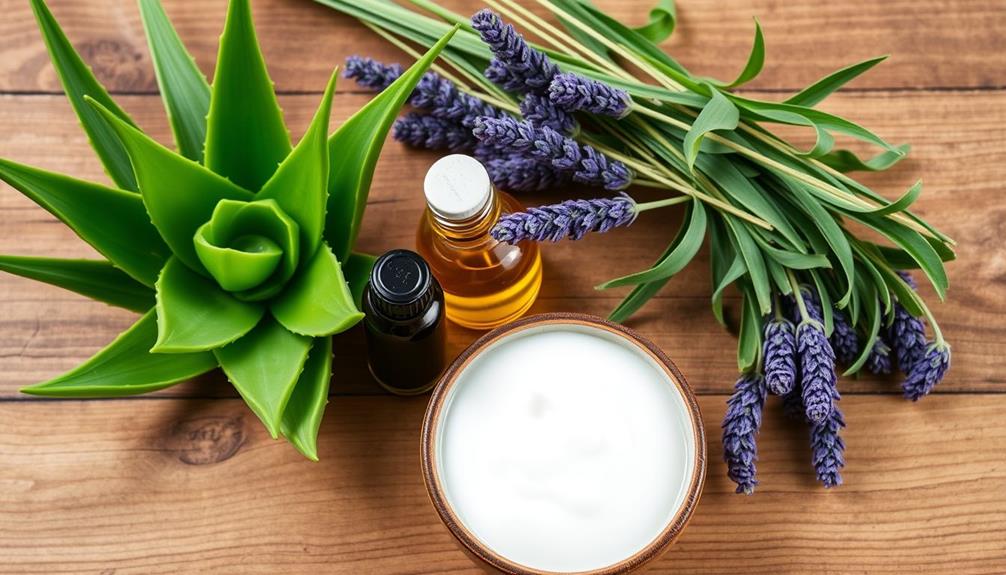
Exploring alternatives for scalp care can help you find effective treatments that suit your individual needs and preferences. While glycolic acid is a popular choice, there are other options worth considering to address various scalp conditions, promote hair regrowth, and combat dandruff.
Here are four alternatives you might explore:
- Minoxidil: An FDA-approved solution for hair regrowth, particularly effective for those experiencing thinning hair.
- Salicylic Acid: This exfoliating agent targets oil buildup and can help with acne on the scalp, providing a different approach than glycolic acid.
- Anti-fungal Shampoos: Formulations containing ketoconazole or zinc pyrithione can effectively treat dandruff and other scalp conditions without the need for exfoliation.
- Essential Oils: Natural options like rosemary and peppermint may promote hair growth and enhance scalp health, offering a holistic alternative.
Frequently Asked Questions
What Does Glycolic Acid Do for the Scalp?
Glycolic acid exfoliates your scalp, removing dead skin and buildup. It hydrates, balances pH, and promotes collagen production, helping to prevent dandruff, unclog follicles, and potentially support healthier hair growth for you.
How Long Should You Leave Glycolic Acid on Your Scalp?
You should leave glycolic acid on your scalp for 10 to 30 minutes, starting with 5-10 minutes if you're a first-time user. Gradually increase the time for ideal results based on your scalp's sensitivity.
What Are the Cons of Glycolic Acid on Scalp?
Glycolic acid can irritate your scalp, causing redness and itchiness. Overusing it might dry out your scalp and weaken your hair, leading to potential hair loss. Always monitor your scalp's reaction when using it.
What Is the Effect of Using Glycolic Acid in Hair Care Products?
Imagine your hair's got a personal trainer! Using glycolic acid in hair care products exfoliates your scalp, boosts moisture, enhances ingredient absorption, balances pH, and helps tackle scalp issues like acne and dandruff.
Conclusion
Just like a gardener tends to their plants, nurturing them with the right nutrients, you can cultivate a healthier scalp with glycolic acid.
This powerful ingredient can prune away dead skin and encourage new growth, revealing a vibrant landscape beneath.
However, just as every garden needs balance, so does your scalp care routine.
Embrace glycolic acid, but remember to remain vigilant, ensuring your scalp flourishes without the weeds of irritation or imbalance.
Your scalp deserves its own thriving ecosystem!
